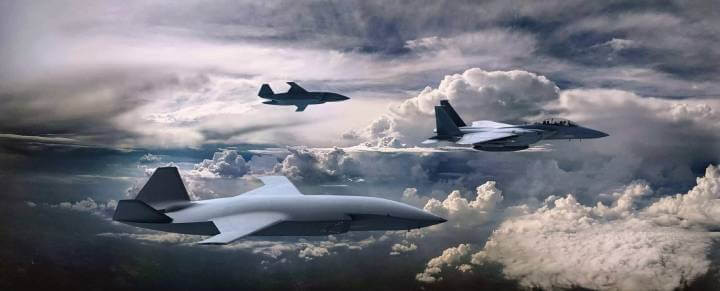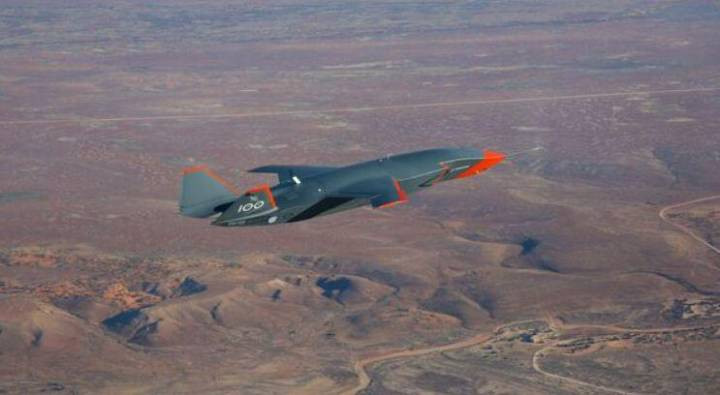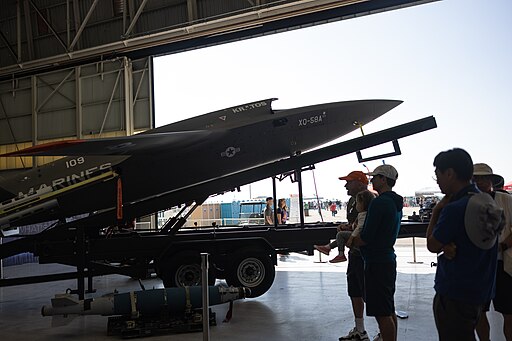6th Gen Aerial Warfare: AI & Autonomous Combat Drones
Insights | 18-01-2024 | By Gary Elinoff

Essential Insights into Advanced Military Drones:
- Innovative AI drone technology is being tested with F-16 Fighting Falcon conversions, transforming these classic fighters into unmanned aerial vehicles (UAVs).
- The XQ-58A Valkyrie drone, a purpose-built UAV, offers cost-effective solutions in modern warfare with an estimated price of two to three million dollars per unit, marking a significant step in affordable drone technology.
- Expanding the global reach of drone development, the MQ-28A Ghost Bat, an innovative UAV, is currently under production in Australia, showcasing the international collaboration in next-generation drone capabilities.
- Highlighting the advancements in autonomous defense systems, General Dynamics’ Phalanx CIWS demonstrates the existing potential for machines to independently engage targets following initial authorization, a leap in autonomous military technology.
Introduction
It’s now widely known that the US is developing a 6th generation aircraft. Among the planned attributes of the next generation air dominance (NGAD) stealth fighter is some of the speed and maneuverability of 4th generation fighters and, of course, the stealth of 5th generation fighters.
The key added element is the ability of piloted NGADs to operate a number of unmanned, AI (Artificial Intelligence)-enhanced drones. The idea is that, at least to some extent, the NGAD and its human pilot can stay largely out of the “danger zone”, sending in the drones to do reconnaissance or to conduct actual combat.
Project Venom, a brainchild of the US Air Force, is a striking example of this new era in combat strategy. It's not just about the tech; it's about redefining the rules of engagement. Imagine F-16s, those stalwarts of the skies, reborn as unmanned drones, each a testament to the ingenious marriage of AI and military acumen. This isn't just evolution; it's a revolution in the skies, a bold leap into a future where AI is the co-pilot and strategy is rewritten in the language of algorithms.
The advantages are multifold. First and foremost, the shift to unmanned aerial systems in modern warfare represents a greatly reduced risk that a US or allied pilot must endure. The drone will be far cheaper because it won’t need life support or pilot protection features. Furthermore, while a human pilot is severely limited in the amount of G Forces (he) can endure, the tolerance that a machine such as a fighter jet can tolerate is, of course, far greater. These advancements in military drone technology not only reduce costs but also open new horizons in aerial combat tactics.
Enter the 'Loyal Wingmen' – these aren't your run-of-the-mill drones. We're talking about sophisticated, AI-driven machines like the XQ-58A Valkyrie. These drones are more than just wingmen; they're the vanguard of a new combat doctrine. Autonomous, yet in lockstep with their human counterparts, they represent a fusion of strategy and technology, reshaping the battlefield into a domain where risk is calculated by algorithms and victories are scripted by AI.
Lastly, while controllers can’t throw caution completely to the wind, the fact that the drone is relatively cheap and there are no US or Allied lives being placed at risk allows mission controllers to opt for far riskier operations. Indeed, with no friendly lives on the line, war planning can be done on a largely material cost/benefit basis.
What’s AI Got to do with it?
Plenty! According to an article published in the USAF’s Airman[1] Magazine, the Air Force’s Chief Scientist, Dr Victoria Coleman, describes that “You need AI because human beings can only go so fast.” She goes on to state that “You can do it the dumb way, going through all the possible 25 billion combinations, or you can build models of what successful engagements look like and then use that versus this exhaustive kind of search. That is really important because when you talk about efficient, distributed, dynamic targeting, you're talking about making decisions at the edge.”
Dr Colemen goes on to describe these capabilities as being evaluated “through a triad of autonomy programs. One of them is the CCA (Collaborative Combat Aircraft) program. The other one is VENOM. Then the EOU (Experimental Operations Unit) team.”
The integration of AI-driven defense systems in these programs marks a pivotal shift towards more intelligent and autonomous military operations, paralleled by the rapid adaptation of concepts like edge computing in various other industries.
Project Venom
“Venom” stands for Viper Experimentation and Next-generation Operations Model, and at its core is the venerable F-16 Viper, modified to serve as a drone and infused with powerful artificial intelligence (AI) capabilities. At first, these specialized F-16s will have human pilots who will be involved in validating the new Collaborating Combat Aircraft (CCA) concept. A fleet of 1,000 CCAs is envisioned: two each for 300 F-35s and another two each for 200 of the eventually developed NGAD. The development of these next-generation military drones is set to redefine the landscape of aerial warfare, offering unprecedented capabilities.
As described in an article published in Forces.net[2], an initial six modified F-16s will be employed to “develop one AI software engine that could be used in a variety of current and future aircraft, instead of investing in multiple individual programmes for pilotless flight on specific aircraft.”
Project Valkyrie
The XQ-58A, the Valkyrie, is being built by the US company Kratos. It will be designed from the ground up as a pilotless drone. It will combine AI with its own sensors to perform reconnaissance and then, with a go-ahead from human authority, to go in for the kill.
U.S. Marine Corps photo by Lance Cpl. Samantha Devine, Public domain, via Wikimedia Commons
As noted in an article posted in IEEE Spectrum[3], the XQ-58A is an exemplar of the “loyal wingman” concept, where a human pilot supervises a flock of relatively inexpensive but AI-guided drones. Indeed, Spectrum states that the AI-enabled Valkyrie is projected to cost a mere $2 million each, even if only 100 are produced each year. Compare that to the $80 million cost for the F-35, one of the warplanes for which it may serve as a “loyal wingman.”
The Valkyrie is nine meters long and has a range of 5,600 kilometers, far greater than either the F-16 or the F-35. And, as illustrated in the picture above, the stealthy drone can itself release smaller drones to bedevil any enemy, as well as host an ever-expanding array of other weapons.
The Experimental Operations Unit
The EOU (Experimental Operations Unit) team is starting the process of developing tactics and procedures and forging them into operational capabilities.

Illustration of combined manned and unmanned aerial formations envisioned in the US Air Force's future operations. (U.S. Air Force Illustration). Image source: Airman Magazine
The EOU team is taking the results of projects Venom and Valkyrie, as well as results from other programs, and applying them to build actual, operating human-machine warplane squadrons.
The Chinese Threat to be Countered by “Affordable Mass”
China has installed over a thousand anti-ship missiles along its coast and along the artificial islands it’s built in the South China Sea. In the event of a Chinese invasion of Taiwan, fleets of CCAs will allow the US and its allies to blunt the Chinese aggression while at the same time limiting aircrew casualties.
It is hoped that, among other things, the AI-powered CCAs, built on the cheap, can serve as non-living “cannon fodder” with the aim of both saving allied lives and keeping the monetary costs down. The concept has been described by the USAF as “affordable mass”. As described in an article in the New York Times[4], in addition to drones designed to be “Loyal Wingmen”, others will be built to specialize in surveillance and resupply, while still others will be designed to form swarms and engage in direct combat against opponents, including that most essential task of destroying enemy missile installations.
The Pentagon’s New Paradigm
The New York Times (NYT) article describes something very different in the way the military plans to do business in the era. Traditional fighters, such as the F-35, are delivered in a package – both hardware and software included. Perhaps no more.
The Pentagon may be seeking to disrupt the control that a few gigantic contractors have on US military spending. This time around, software, particularly AI software, will be purchased separately from hardware. The military’s aim is to utilize the energy of a new generation of fast, agile software companies to deliver key parts of the package with the goal of increasing entrepreneurial energy and competition in what has been described by the NYT article as “a risk-averse and slow-moving system.” Up-and-coming companies, such as venture capital-funded Shield AI and Anduril, are cited.
The Pentagon's latest strategy, splitting AI software from hardware, is more than a procurement policy; it's a strategic gambit. It's about breaking the mold and bringing in the agility and innovation of smaller, tech-savvy firms. This isn't just diversification; it's a deliberate disruption, a move to infuse the military's technological veins with fresh, entrepreneurial blood, promising a future where defense is as much about cutting-edge software as it is about firepower.
Of course, traditional defense giants have also thrown their hats into the ring. The MQ-28A Ghost Bat, produced by Boeing Australia, is a part of that effort.

Boeing Australia’s The MQ-28A Ghost Bat. Image source: Janes
This stealthy drone is being designed with primarily the “loyal wingman” concept in mind. Conceived with modularity as a key feature, the Ghost Bat features different interchangeable “nose” sections, each containing different payloads specific to different sorts of missions.
Challenges and Opportunities
A main objection to the entire concept of combat drones is the apprehension involved in letting a machine decide whether to kill or not. But, it seems as though that particular Rubicon has already been crossed, courtesy of General Dynamics’ Phalanx CIWS.
National Archives at College Park - Still Pictures, Public domain, via Wikimedia Commons
As described by the US Navy[5], “Phalanx automatically detects, evaluates, tracks, engages and performs kill assessment against ASM and high-speed aircraft threats.” The key term here is “kill assessment.” It has also been described as useful against small boats. Since both aircraft and small boats are generally piloted by humans, we already have a machine that decides on its own whether to kill human enemies, albeit with serious constraints.
So, whatever the morality, the die has already been cast.
Wrapping Up
Drones have one enormous advantage over manned vehicles, and that is if it goes down, it doesn’t take a pilot with it.
The F-16, at least in the United States, is like a 2023 car after the 2024s have arrived; the dealers want to get rid of it. So the plane, available by the hundreds or maybe even in the thousands, is essentially free, and AI software can be downloaded to new drones as often as necessary.
But the F-16 is better than anything that the Russians have in production, and it is also most likely superior to what the Chinese have in meaningful quantities. Modified with AI software to serve as a drone and under the control of a nearby manned combat aircraft, it might even be more effective than a manned F-16 – reaction times will be faster, and the weight of the life support systems will be eliminated. Drones like the Valkyrie, at two or three million dollars a pop, are cheap enough to be deployed in swarms, overwhelming enemy defenses.
As of this writing, the US and UK are forced to use long-range, multi-million dollar missiles to take out targets whose monetary value is a small fraction of the missile’s cost. Using a stealthy drone to get in close, too close to risk as a pilot and an $80 million F-35, allows for the use of a far less expensive bomb or missile whose range is smaller and whose payload may well be larger.
References:
- Command Interview: AF Chief Scientist Dr. Victoria Coleman: https://www.airmanmagazine.af.mil
- Project Venom: The future of autonomous flight in the US Air Force: https://www.forces.net
- The USAF Pairs Piloted Jets With AI Drones: https://spectrum.ieee.org
- AI Brings the Robot Wingman to Aerial Combat: https://www.nytimes.com
Glossary of Key Terms:
- CCA (Collaborating Combat Aircraft): Advanced aircraft designed to work in conjunction with other military assets, enhancing collaborative combat capabilities.
- Loyal Wingmen: Unmanned drones engineered to operate alongside manned aircraft, providing support and expanding operational capacities.
- NGAD (Next-Generation Air Dominance): A cutting-edge stealth fighter program focused on developing superior air combat technologies for future warfare.
- Venom (Viper Experimentation and Next-Generation Operations Model): A program involving the transformation of F-16 Vipers into AI-enhanced drones, pioneering new approaches in aerial combat.



